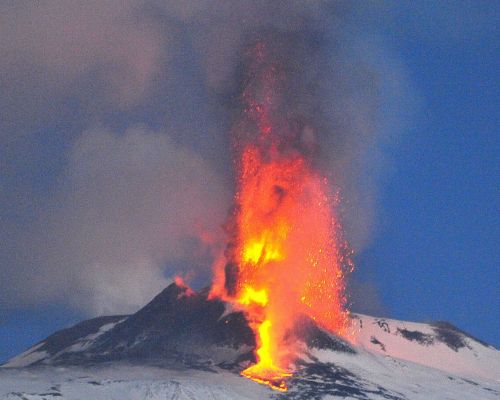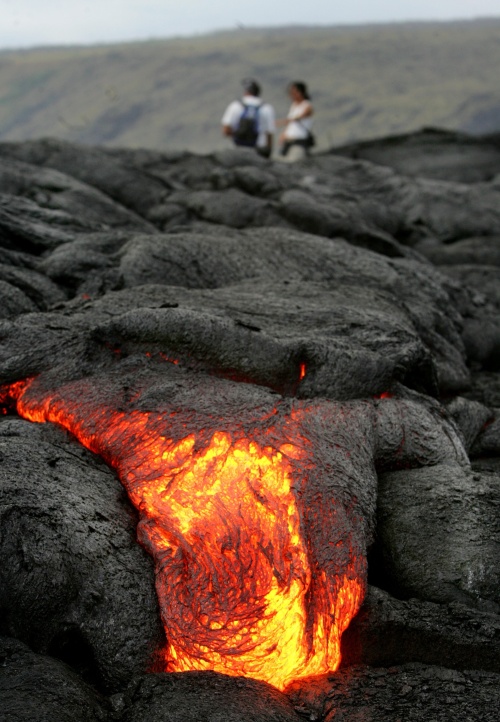Around 1630 B.C., a super-volcano blew apart the Aegean island of Santorini, an event so violent that some theorists say it nurtured the legend of Atlantis.
More than three and a half millennia later, the big blast is yielding forensic clues which help the search to predict future cataclysmic eruptions, scientists said on Wednesday.
 |
Etna Volcano on the southern Italian island of Sicily erupts on Jan. 6. (AFP-Yonhap News) |
 |
Lava lurks beneath Kilauea, an active volcano on the big island of Hawaii. (MCT) |
Bigger than the destruction of Indonesia’s Krakatoa in 1883, the Santorini event was a so-called caldera eruption, a kind that happens mercifully only at intervals of tens of thousands of years, sometimes far more.
The chamber of a volcano becomes progressively filled with magma but lacks vents from which to discharge this dangerous buildup of gas and molten rock.
The pressure cooker culminates in catastrophe, ripping off the top of the volcano and leaving a depression called a caldera, the Spanish word for cauldron.
One of the great unknowns is when a caldera-type episode is in the offing.
That question is a particular concern for Yellowstone Park in Wyoming, a truly massive volcano classified as “high-threat” by the U.S. Geological Survey.
Volcanologists led by French-based Timothy Druitt scrutinized crystals of a mineral called feldspar that had been ejected from the Santorini eruption.
They looked for traces of magnesium, strontium and titanium, deposited in waves over thousands of years by the slowly advancing magma. The chemicals, they found, were a telltale of events over time.
From these signatures, the picture that emerges is of final, fatal spurts of magma injection which happened in the last decades -- maybe even just the final months -- before the great eruption.
The study, reported in the journal Nature, chimes with other research that suggests magma reservoirs in caldera volcanoes undergo a “pulsatory” buildup which probably accelerate before eruption.
If so, the findings are useful for volcanologists poring over Yellowstone and other hotspots. They could detect such pulses using satellite technology, which records ground deformation over time as the volcano bulges, and ground-motion sensors.
But only close familiarity helps build a “pulse” model which gives a good idea of when a volcano is about to blow its lid.
“Long-term monitoring of large, dormant caldera systems, even in remote parts of the world, is essential if late-stage growth spurts of shallow magma reservoirs are to be detected well in advance of caldera-forming eruptions,” says the paper.
Also called the Minoan Eruption, the Santorini event spewed out up to 60 cubic kilometers of material, causing ash clouds that devastated Bronze Age civilizations in the Aegean.
Some theorists say the event inspired Plato’s tale, written some 1,300 years later, of a circular island-empire inhabited by people of great culture and wealth, that sank to the depths of the sea in a single day and night of earthquakes and floods. (AFP)
<관련 한글기사>
슈퍼 화산 폭발, 수십년 전 예측 가능
몇만 년에 한 번씩 일어나는 초대형 화산 폭발을 수십년 전에 예측할 수 있다는 최신 연구가 나왔다고 BBC와 MSNBC가 1일 보도했다.
프랑스 블레즈 파스칼 대학 연구진은 그리스 산토리니 섬의 화산 분화구에서 채 취한 암석 결정을 분석한 결과 약 3천700년 전 이 섬의 화산이 대폭발을 일으키기 수십년 전부터 마그마가 빠르게 축적된 것으로 나타났다면서 첨단기기를 사용하면 이런 현상을 사전 예측할 수 있다고 네이처지에 발표했다.
절정기의 미노스 문명을 하루 아침에 사라지게 해 `아틀란티스’ 전설의 기원으로 여겨지기도 하는 산토리니 화산 폭발은 화산학자들이 ‘슈퍼 화산’으로 분류하는 규모에는 못 미치지만 지난 1만년 사이 최대의 폭발 중 하나로 꼽힌다.
지구상에 존재하는 10여개의 `슈퍼화산’은 역사적으로 기록이 남아있는 최악의 화산 폭발보다 수천 배 많은 마그마와 화산재를 분출할 수 있다.
이를테면 7만4천년 전에 일어난 인도네시아 수마트라 섬의 토바화산 폭발 때는 2천800㎦의 마그마와 재가 분출됐다. 이에 비하면 최대 등급의 재난으로 기록된 지 난 1883년 인도네시아 크라카토아 화산 폭발 때는 12㎦, 산토리니 화산 폭발 때는 40~60㎦의 마그마가 분출됐다.
슈퍼화산들은 수십만년 동안 휴면 상태를 유지하는 것이 보통이며 과학자들은 여러 자료들을 종합하면 몇 달 전에 폭발을 예측할 수 있다고 보지만 충분한 대비에 는 턱없이 짧은 시간이다.
연구진은 산토리니의 화산석인 장석 (長石 feldspar)의 결정체를 전자현미경과 이온현미경 등 첨단 장비로 분석한 결과 이 화산이 오랜 휴면기가 지난 뒤 수십년 동안 마그마가 지하 수㎞까지 서서히 차 올랐다가 분화구를 통해 맹렬하게 분출한 것으로 나타났다.
강력한 폭발로 화산 정상부가 날아가 버리고 남은 부분은 침강해 `칼데라(화산호수) 형성 분출’로 불리는 이런 대폭발의 흔적은 미국 옐로스톤 국립공원이나 이탈리아 캄피 플레그레이 등 세계 곳곳에서 찾아 볼 수 있지만 지금은 모두 휴면상태에 있다.
연구진은 장석 결정체 300개를 분석해 마그네슘과 같은 원소들이 확산된 속도를 밝혀냄으로써 마그마굄에서 진행된 화산활동의 속도를 알아낼 수 있었으며 결과는 다소 충격적이었다고 말했다.
즉 수십년이란 짧은 기간에 마그마의 성분에 큰 변화가 일어난 것이다.
지금까지 학자들은 마그마가 차 오르는 현상이 수천~수십만년에 걸쳐 서서히 진행됐을 것으로 생각해 왔지만 실제 분석 결과는 완전히 다르게 나타났다.
연구진은 산토리니 화산이 폭발하기 전 마그마굄에 마그마가 다시 차오르기까지는 100년도 안 걸렸으며 분출 직전 마지막 몇 달 동안에도 각기 다른 마그마 흐름 들이 계속 섞이고 있었다고 밝혔다.
연구진은 장비만 제대로 갖추고 면밀히 관찰한다면 화산이 폭발하기 수십년 전 에 이를 탐지할 수 있을 것이라고 강조했다.
이들은 그러나 이런 현상이 일어나는 원인은 아직 밝혀지지 않았으며 새로운 연구의 대상이라고 말했다. (연합뉴스)









![[Today’s K-pop] Blackpink’s Jennie, Lisa invited to Coachella as solo acts](http://res.heraldm.com/phpwas/restmb_idxmake.php?idx=644&simg=/content/image/2024/11/21/20241121050099_0.jpg)